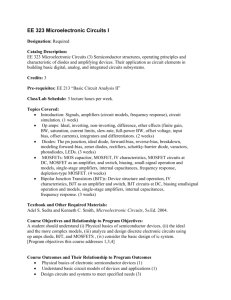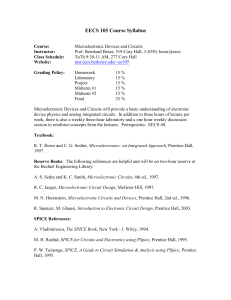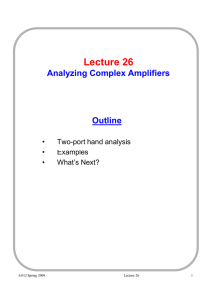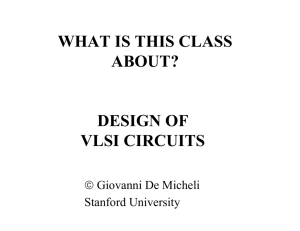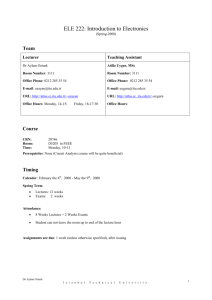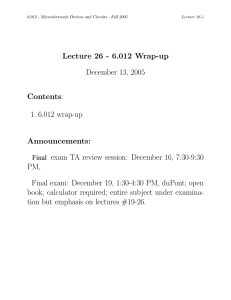Document 13578670
advertisement
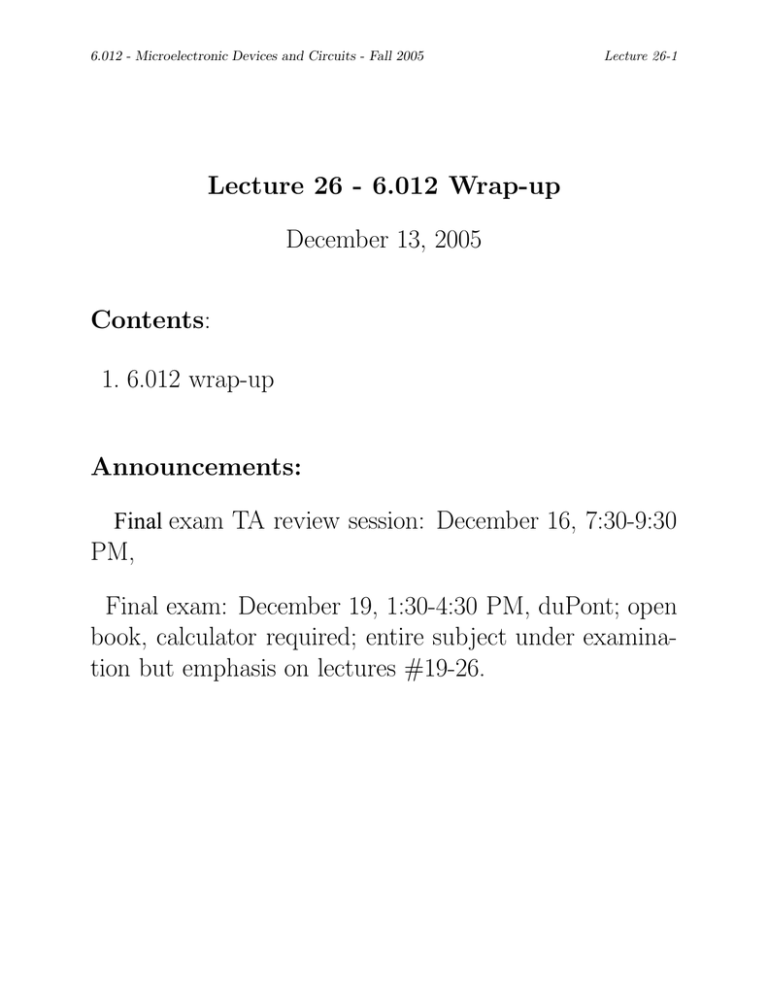
6.012 ­ Microelectronic Devices and Circuits ­ Fall 2005 Lecture 26­1 Lecture 26 ­ 6.012 Wrap­up December 13, 2005 Contents: 1. 6.012 wrap­up Announcements: Final exam TA review session: December 16, 7:30­9:30 PM, Final exam: December 19, 1:30­4:30 PM, duPont; open book, calculator required; entire subject under examina­ tion but emphasis on lectures #19­26. 6.012 ­ Microelectronic Devices and Circuits ­ Fall 2005 Lecture 26­2 1. Wrap up of 6.012 �The amazing properties of Si • two types of carriers: electrons and holes –however, can make good electronic devices with just one, i.e. MESFET (Metal­Semiconductor Field­ Effect Transistor), or HEMT (High Electron Mo­ bility Transistor) –but, can’t do complementary logic (i.e. CMOS) without two 6.012 ­ Microelectronic Devices and Circuits ­ Fall 2005 Lecture 26­3 • carrier concentrations can be controlled by addition of dopants – over many orders of magnitude (about 20!) – and in short length scales (nm range) Image removed due to copyright restrictions. 37 nm gate length MOSFET from Intel (IEDM ’05). 6.012 ­ Microelectronic Devices and Circuits ­ Fall 2005 Lecture 26­4 • carrier concentrations can be controlled electrostati­ cally over many orders of magnitude (easily 10!) 6.012 ­ Microelectronic Devices and Circuits ­ Fall 2005 Lecture 26­5 • carriers are fast: – electrons can cross L = 0.1 µm in about: L 0.1 µm = 1 ps τ= = 7 ve 10 cm/s –high current density: Je = qnve = 1.6 × 10−19 C × 1017 cm−3 × 107 cm/s = 1.6 × 105 A/cm2 ⇒ high current drivability to capacitance ratio • extraordinary physical and chemical properties –can control doping over 8 orders of magnitude (p type and n type) –can make very low resistance ohmic contacts –can effectively isolate devices by means of pn junc­ tions, trenches and SOI 6.012 ­ Microelectronic Devices and Circuits ­ Fall 2005 Lecture 26­6 �The amazing properties of Si MOSFET body polysilicon gate source drain gate n+ p+ n+ n+ p n inversion layer� channel gate oxide • ideal properties of Si/SiO2 interface: –can drive surface all the way from accumulation to inversion (carrier density modulation over 16 orders of magnitude) –not possible in GaAs, for example 6.012 ­ Microelectronic Devices and Circuits ­ Fall 2005 Lecture 26­7 • performance improves as MOSFET scales down in size; as L, W ↓: – current: W µCox (VGS − VT )2 unchanged 2L – capacitance: ID = Cgs = W LCox ↓↓ – figure of merit for device switching delay: CgsVDD 2VDD 2 =L ↓↓ ID µ(VGS − VT )2 • No gate current. • VT can be engineered. • MOSFETs come in two types: NMOS and PMOS. • Easy to integrate. 6.012 ­ Microelectronic Devices and Circuits ­ Fall 2005 Lecture 26­8 � The amazing properties of Si CMOS • Rail­to­rail logic: logic levels are 0 and VDD . • No power consumption while idling in any logic state. • Scales well. As L, W ↓: – Power consumption (all dynamic): 2 2 Pdiss = f CLVDD ∝ f W LCoxVDD ↓↓ – Propagation delay: tP ∝ CLVDD ↓↓ W 2 µCox (VDD − VT ) L –Logic density: 1 1 Density ∝ = ↑↑ A WL 6.012 ­ Microelectronic Devices and Circuits ­ Fall 2005 Lecture 26­9 Cell Area (um2) 100 10 0.57 um2 cell on 65 nm generation 0.5x every 2 years 1 0.1 1993 1995 1997 1999 2001 2003 2005 Transistor density continues to double every 2 years INTEL 6-T SRAM CELL SIZE TREND Figure by MIT OCW. 2007 6.012 ­ Microelectronic Devices and Circuits ­ Fall 2005 Lecture 26­10 Transistors 1,000,000,000 Itanium R 2 Processor Itanium R Processor 100,000,000 Pentium R 4 Processor Pentium R III Processor Pentium R II Processor 10,000,000 Pentium R Processor 286 8086 8008 486TM DX Processor 386TM Processor 100,000 10,000 8080 4004 1970 1975 1,000,000 1980 1985 1990 1995 MOORE'S LAW Figure by MIT OCW. 2000 1,000 2005 6.012 ­ Microelectronic Devices and Circuits ­ Fall 2005 Lecture 26­11 � MOSFET scaling Straight MOSFET scaling doesn’t work. • electric field increases Ey � VDD ↑ L • power density increases 2 Pdiss f W LCoxVDD 2 = f CoxVDD ∝ device area WL But Pdiss ↑↑⇒ T ↑↑ tP ↓↓⇒ f ↑↑⇒ device area 6.012 ­ Microelectronic Devices and Circuits ­ Fall 2005 Lecture 26­12 • total power increases Power (watts) 100 10 0 1985 1987 1989 1991 1993 1995 1997 1999 2001 2003 Year INTEL POWER OVER TIME Figure by MIT OCW. 6.012 ­ Microelectronic Devices and Circuits ­ Fall 2005 ⇒ must scale VDD Lecture 26­13 6.012 ­ Microelectronic Devices and Circuits ­ Fall 2005 Where is this going? Image removed due to copyright restrictions. Lecture 26­14 6.012 ­ Microelectronic Devices and Circuits ­ Fall 2005 Lecture 26­15 The future of microelectronics according to Intel: Image removed due to copyright restrictions. 6.012 ­ Microelectronic Devices and Circuits ­ Fall 2005 Lecture 26­16 � Exciting times ahead in Si IC technology: • analog electronics (since ∼ 50� s): amplifiers, mixers, oscillators, DAC, ADC, etc. • digital electronics (since ∼ 60� s): computers, micro­ controllers, random logic, DSP • solid­state memory (since ∼ 60� s): dynamic random­ access memory, flash • energy conversion (since ∼ 70� s): solar cells • power control (since ∼ 70� s): ”smart” power • communications (since ∼ 80� s): VHF, UHF, RF front ends, modems, fiber­optic systems • sensing, imaging (since ∼ 80� s): photodetectors, CCD cameras, CMOS cameras, many kinds of sensors • micro­electro­mechanical systems (since ∼ 90� s): ac­ celerometers, movable mirror displays • biochip (from ∼ 2000): DNA sequencing, µfluidics • vacuum microelectronics (from ∼ 2000?): field­emitter displays • ??????? (microreactors, microturbines, etc.) 6.012 ­ Microelectronic Devices and Circuits ­ Fall 2005 Lecture 26­17 � Circuit design lessons from 6.012: 1. Importance of optimum level of abstraction: • device physics equations, i.e.: W µCox (VGS − VT )2 , etc. ID = 2L • device equivalent circuit models, i.e.: id Cgd G D + vgs Cgs Cgb gmbvbs gmvgs ro - S - vbs B Csb + Cdb • device SPICE models, i.e.: drain − qBD+ ID RD + qGD− − D′ vGD′ gate + − vBD′ + IS IDS(VGS,VDS,VBS) + qGS− S′ + qGB− IS − vBS' + RS − qBS+ source bulk 6.012 ­ Microelectronic Devices and Circuits ­ Fall 2005 Lecture 26­18 2. Many considerations in circuit design: • multiple performance specs: –in analog systems: gain, bandwidth, power con­ sumption, swing, noise, etc. –in digital systems: propagation delay, power, ease of logic synthesis, noise, etc. • need to be immune to temperature variations and de­ vice parameter variations (i.e.: differential amplifier) • must choose suitable technology: CMOS, BJT, CBJT, BiCMOS, etc. • must avoid costly components (i.e.: resistors, capac­ itors) 3. Trade­offs: • gain­bandwidth trade­off in amplifiers (i.e.: Miller ef­ fect) • performance­power trade­off (i.e.: delay in logic cir­ cuits, gain in amplifiers) • performance­cost trade­off (cost=design complexity, Si area, more aggressive technology) • accuracy­complexity trade­off in modeling 6.012 ­ Microelectronic Devices and Circuits ­ Fall 2005 Lecture 26­19 � Exciting times ahead in circuit design too: • Numbers of transistors available outstrips ability to design by 3 to 1! • Operational frequency of logic, analog, and communi­ cations circuits increasing very fast. • Operational voltage shrinking quickly. • New device technologies: GaAs HEMT, InP HBT, GaN HEMT, etc 6.012 ­ Microelectronic Devices and Circuits ­ Fall 2005 Lecture 26­20 More subjects in microelectronics at MIT • 6.152J ­ Micro/Nano Processing Technology. The­ ory and practice of IC technology. Carried out in clean rooms of Microsystems Technology Laborato­ ries. Fulfills Institute or EECS Lab requirement. Fall and Spring. • 6.301 ­ Solid­State Circuits. Analog circuit design. Design project. Spring. G­level. • 6.334 ­ Power Electronics. Power electronics devices and circuits. Spring. H­level. • 6.374 ­ Analysis and Design of Digital Integrated Circuits. Digital circuit design. Design projects. Fall. H­level. • 6.720J ­ Integrated Microelectronic Devices. Mi­ croelectronic device physics and design. Emphasis on MOSFET. Design project. Fall. H­level.
